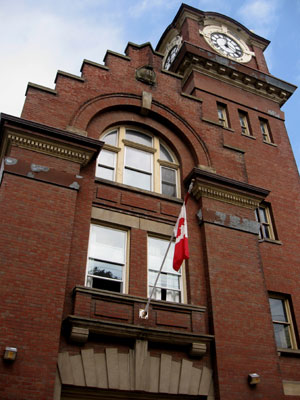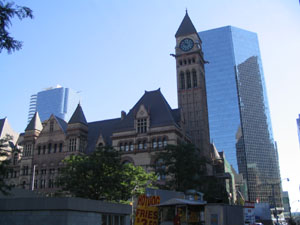Having just completed my interview with Lido Chilelli, the creator of the Toronto International Beaches Jazz Festival, I was planning to head east on Queen Street to find a nice place for lunch. As I was walking eastwards, taking in the streetscape, I realized that one place is and continues to be a definite fixture in the Beach: just a few steps from the intersection of Woodbine and Queen is Toronto Fire Station 227, housed in an elegant historic building that is now more than 100 years old. I thought there was a story in there somewhere and made up my mind to pop in.
I decided to try my luck and drop in unannounced on the firefighters for an impromptu interview. I opened the back door and saw a bunch of firefighters’ uniforms hung up on hooks and thought I had reached their change room. I concluded it was not a good idea to barge in there. So I tried the side door and sure enough, after a couple of knocks the door opened and one of the firefighters on duty let me in.

Fire Station 227, a historic landmark in the Beach
After I introduced myself and the “Celebrate Toronto” project, Bill Libbus, a First Class Firefighter, checked with his captain to see if it was okay for me to interview him, and after he got the green light he started to show me around. He first showed me the fire truck which was parked on the main floor inside the fire station. A pair of firefighter’s boots and a uniform were standing on the ground as if someone had flown right out of them, and I thought that made a perfect humorous still life.
Then Bill showed me the fire tower, a 80 foot high tower that actually has a purpose other than to just house the famous clock. The fire tower is indeed used to hang up wet fire hoses that need to dry. Bill added that most people don’t realize that the fire towers on the old fire stations have a practical purpose; people often think they are only there for decorative purposes or to house the clock.

Humorous still life
Of course he also showed me the slide (actually two slides) that firefighters would use to slide down from the second floor. And he showed me an old gong used to rattle up the firefighters for an emergency response, which actually is no longer in use today.
With most of the main sights covered, we sat down in the kitchen and Bill started to educate me about the duties and the life of Toronto firefighters. He himself has been here at this station for 17 years. The building is truly historic, it was built in 1905, and more than 100 years ago firefighters would use horses to pull their equipment. It was originally called Fire Station #17, but since Toronto’s 1999 amalgamation with the former municipalities of North York, East York, York, Etobicoke and Scarborough, the fire station was renamed. Today, Fire Hall 227 has one pumper truck which requires a crew of four firefighters: a captain who is in charge and responsible for the safety of the three firefighters on his crew.

Bill Libbus with the metal pole
Bill explained that other fire stations might have more trucks, or they might have different equipment, for example aerial trucks which are equipped with ladders for emergency calls to high rise buildings. I inquired into the routine of the firefighters, and Bill explained that during the day they have regular training sessions in order to re-familiarize themselves with safety, first aid, CPR, fire and truck procedures as well as firefighter policies.
Fire fighters are first responders, which means that if someone calls 911 because of a heart attack, often a fire truck will get there first and provide CPR, oxygen or defibrillation equipment. Toronto has more fire stations than ambulance stations which explains why a fire truck might often be the first emergency vehicle to arrive on the scene. Toronto firefighters often handle patient transport to the hospitals and about 50% of their emergency calls are of a purely medical nature.

Logo in the fire fighters’ change room
I learned that the area that Fire Station 227 is responsible for stretches from Coxwell in the west to Victoria Park in the east, and from the lakeshore in the south to Danforth Avenue in the north. Bill explained that all fire calls require two pumper trucks, one aerial truck and a fire chief. Each of Toronto’s 21 fire districts has its own district chief who usually races to a fire in a red van. When Station 227 responds to a fire, the aerial truck comes from the fire station on Main Street. As an example, Bill mentioned that today there was a fire in the Main and Danforth area in a private house, and it took the crew four hours to extinguish the fire. The fire chief was still scheduled to go back to the location later today for further investigations.
As far as the Beach is concerned, Bill Libbus explained that almost all the fires are residential in nature. There are very few high rise buildings and no industrial locations in the area. About five years ago there was a major fire at the eastern end of Queen Street where two people died and about 20 fire trucks were called out. When two pumper trucks and the aerial truck are not enough, additional fire crews are called out with four vehicles each, and the response to the emergency gets escalated into two, three, four or more alarm fires, meaning that additional teams of four vehicles are pulled in. Bill also referred to Toronto’s Great Fire of 1907 where the whole city was burning. He could not even speculate how many alarms this type of fire would have triggered. Literally every fire fighter would have been called in to extinguish this historic inferno.

Captain Bill Elliot, District Chief Bob Buchan, Bill Libbus




